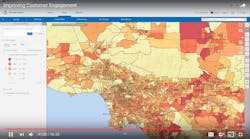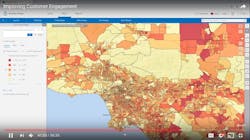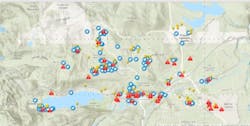Do utilities do a good job of engaging customers? In a recent study by the American Consumer Satisfaction Index (ACSI), utilities ranked low, scoring 72.5% — a C grade. The ACSI, founded in 1994, helps industries benchmark themselves against other industries.
Why the low rating for utilities? Is it too many power failures or high bills? Or is it too often that customers get the dreaded message, "We are experiencing higher-than-normal call volumes"?
Here's how utilities answer those questions and improve customer satisfaction. First, they get data from customer satisfaction surveys, read complaint letters, listen to customer phone calls, hear from politicians, and have to measure reliability. Worse, they get criticized by their public utility commission (PUC). Then they try to figure out what to do with that information.
Lacking solid analysis of data, utility companies resort to doing what they do best. They work on their assets and operations — upgrading equipment or increasing maintenance. They trim trees more frequently or add staff to call centers. They employ technology to automate incoming calls. These are all good and necessary steps that improve reliability, resiliency, security, and network performance. But do any of these measures increase customer satisfaction?
According to the ACSI, the ranking of utilities from 2018 to 2019 fell nearly three points. So why haven't utilities dramatically improved customer satisfaction yet?
A Digital Transformation
Revenue depends on assets and operations. The money utility companies collect is determined by the base rate — the total value of assets minus depreciation. However, customer satisfaction doesn't figure anywhere in that revenue equation. Imagine if the rate of return were to be multiplied by the ACSI satisfaction index. That would change behavior. Certainly, the PUCs listen to customer complaints, putting pressure on utilities to improve customer satisfaction. While the PUCs punish utilities in their rate filings for poor customer service, overall utilities stay focused on assets and operations. But that attitude is changing.
Green Mountain Power (GMP) is a great example of this shift. CEO Mary Powell described the company's customer engagement efforts as an obsession. And Deborah Kimberly, vice president of customer energy solutions and corporate communications at Austin Energy, had this to say about her utility's service philosophy: "They are not meters or ratepayers. They are customers."
In another example, Peoples Gas, based in Pennsylvania, focuses on customer communication. The company, which is more than a century and a half old, uses the latest technology to alert customers about where utility crews will be working. To keep customers and crews up-to-date, Peoples Gas relies on location intelligence backed by geographic information system (GIS) technology.
Though customers understand that sometimes streets must be excavated, no one likes to be surprised when their route is blocked or when their peace is disrupted by the sound of jackhammers pounding the pavement. Utility work is also an issue for small business owners, who don't like it when the entrances to their locations are blocked.
Peoples Gas understands that customers and the community need communication when their daily lives and routines are disrupted. So the company provides a real-time status of its activities.
Having built a strong business on asset strategy and operational excellence, utilities now are shifting to a customer-centric strategy. This isn't to imply that utilities ever ignored their customers. In fact, during power failures, utility companies and workers go well beyond heroics to get the power restored. The problem isn't restoration.
Utilities treat customers as ratepayers — valued and respected, certainly, but not diverse or unique. They tend to use a gut feeling in their customer engagements.
Take tree trimming for example — customers understand that wind and trees can interfere with overhead wires and cause power failures. The obvious gut reaction of the utility is to trim trees. It's the way in which utilities communicate and often execute tree trimming that can create issues.
In a recent news article about customer complaints about tree trimming, people emphasized the lack of communication about when and how their neighborhood trees were to be cut. One person, a self-described "tree hugger," was representative of the neighborhood's very specific demographic. But the utility had no idea who lived in that neighborhood.
Clearly, all ratepayers are not the same. The utility was forced to stop tree trimming because of all the customer complaints. The company could argue that customers should know overgrown trees cause problems, or that tree trimming improves power reliability. But by not understanding customers and their unique sensitivities, the utility inadvertently caused a decrease in customer satisfaction. Utilities often make assumptions about their customers without looking into solid data about them, including factors such as their preferences, income, hobbies, and politics.
So how can a utility company make sense of all the disparate data it so diligently collects?
Opportunity for Engaging Customers Geospatially
By using the same GIS technology, companies can make sense of customer data and rely on coordinating field crews and sharing updates with customers. GIS helps utilities consolidate all kinds of data into one easy-to-use platform with information that can be visualized, shared, and easily understood via maps, apps, and dashboards. Analytics inside the GIS provide tools to help users make sense of it all, then pinpoint where to act on a map.
But since utilities are typically focused on operations and assets, they are not in the habit of using their GIS for customer engagement. Yet, other competitive industries and governments use GIS extensively for customer research, targeting, and outreach.
This presents a big opportunity for utilities. They can use GIS the same way other organizations do, by collecting all their information into a GIS. Utilities can consolidate and analyze data about service or billing complaints, outages, voltage surges, call center interactions, and customer satisfaction scores. Then, they can make key decisions based on the results.
Utilities can also take advantage of valuable datasets to improve their service. The Tapestry Segmentation dataset, for example, provides insight into U.S. population by location. It classifies neighborhoods into 67 unique segments based on not only demographics but also socioeconomic characteristics. This helps utilities design incentives or outreach programs. It also gives them the tools to simplify customer feedback.
These maps and segmentations illustrate three ways utilities can improve customer experiences:
- Understanding customers — GIS provides the ability to draw on all kinds of data sources, including customer complaints, income levels, demographics, neighborhood classification, recent outage experiences, service reliability, and the locations of maintenance or tree trimming. Utilities can use GIS to organize and view information in the context of location.
- Analyzing data — Just visualizing data sources on a map can provide powerful understanding. However, adding analysis, such as correlation of data sources, turns information into scientific insight. GIS-based analysis helps answer questions such as the following: where are the best locations to target energy savings incentives? Where should crews be careful about tree trimming?
- Creating customer engagement — Customers value information and transparency. If a utility executive is asked how to improve customer satisfaction, a gut response might be to increase tree trimming for better reliability or to offer incentives for reducing energy consumption. Those solutions might resonate with one segment of the population but not with others. Having the right data with the right analysis helps ensure that programs designed to bolster customer satisfaction are based on solid evidence.
One easy way for utilities to improve customer experience is to leverage the GIS tools they have been using for years. By expanding the use of the GIS technology they already have, utilities can better understand their customers and convey information in a transparent way — all within a holistic, scalable IT infrastructure. To build greater satisfaction with customers, all utilities need to do is extend the GIS capabilities of their enterprise.
Find out more about how GIS can enhance customer satisfaction here.





